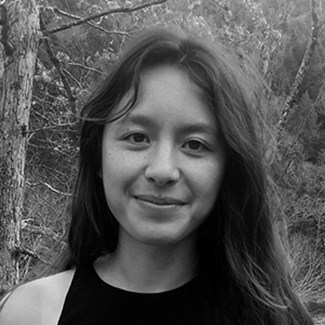
In this workshop, students will be decoding and rewriting site-specific information using Grasshopper and Rhino to design with environment. The intention is to create modes of communication between input, information, and production – to fold environmental understanding into the act of making.
Details
Students will translate environment into image, image into algorithm, and algorithm into design application. These acts of translation will stitch together the acts of observation, illustration, and occupation of space. I will provide a grasshopper script that can translate raster imagery into fields of information that are workable in Grasshopper and Rhino.
As shown in the left-most column in the image above, the raster imagery can be anything from a digital painting, to a drawing, to a photograph, to a map. The only requirement for the image is that it must in some way register a context or environment. As seen in the second and third columns, this visual data can be translated into digital information, represented in 2D and 3D respectively. Students will develop a design intent in groups, and use this capacity for image-based digital information to inform their design logic. For example: with a design intent to equalize light in a space using a screen, darker areas in an image can represent shady areas, which will require larger perforations to let more light in; and lighter areas in an image represent bright areas, which will require smaller perforations to restrict light. With a design intent to create a customized physical sensation on a body using a wearable piece: darker areas in the custom image can represent areas to heat, which will require tighter, thicker material; and lighter areas can represent areas to cool, which will require more porous, or thin material. We will discuss simple ways to affect light, sound, and heat that can have ambient physical effects — creating tangible, but ephemeral and often invisible zones around or within a piece.
The first part of the workshop will involve a lecture to discuss the logic of the project; then a step-by-step walkthrough of the design process using a sample project to solidify student understanding. Then students will break out into their groups to define a design intent, and sketch the beginnings of some design concepts. I will check in with groups to provide feedback and guidance on design concept, work with them on understanding their next steps, and talk through designating different responsibilities within the group.
This workshop involves image-making, digital translation, and fabrication in partnerships that revolve around cohesive, shared design concepts. Each student in a group will specialize in one of these tasks. After the initial concept meeting, the students will spend the majority of the remaining time working on their projects. I will check in with students individually, and once more in their groups. Towards the end of the workshop students will do a quick presentation and get a chance to hear from other groups.
Notes – The type of fabrication students will do will depend on facilities and resources available. Students should be grouped ahead of time to even out skillsets, and each group must have access to at least one computer with Rhino/Grasshopper installed. We should discuss any workflows or plugins they might use before the workshop to ensure compatibility and cut down on spending time with installation or version issues.
Timeline
30 min – lecture, overview, logic
45 min – walking through the script together using sample project
30 min – students break out to discuss concept
30 min – meetings, feedback, next steps
2 hr – break out, work, intermittent meetings
30 min – quick presentations
30 min – quick presentations
Student Skills
(Per Group) At least one student with basic proficiency in Rhino, experience using Grasshopper preferred but not necessary. At least one student with fabrication proficiency.